Small Black Bugs in House (With Pictures) – Identification Guide

Discovering small black bugs in your house can be a frustrating experience. You can come across these tiny dark-colored pests in various areas of the home. The small black bugs can range in size from tiny fleas, ticks, bed bugs, and gnats to larger bugs like carpet beetles, black ants, and pantry weevils.
Identifying small black bugs in the house is crucial for effective elimination. This is because getting rid of the pesky black pests from your home is vital. Some minuscule black creepy crawlies can bite, causing a nasty rash and itchy spots. Other black house bugs infest pantries and can spread disease.
This guide will help you identify common small black bugs found in houses. You will also get handy tips on how to get rid of unwanted six-legged intruders.
How to Identify Small Black Bugs
Identifying small black bugs can be challenging because the bugs can be as tiny as poppy seeds. First, look at the size and shape of the insect. Then note distinguishing features, such as wings, antennae, or patterns on their bodies. Additionally, observe their behavior and habitat.
It’s vital to prevent infestations of small black critters in your house. Typically, common household pests get into buildings through cracks and crevices around window frames and doors. Other small black pests like ticks, pantry bugs, bed bugs, and fleas may hitch a ride on your pets, clothing, or shopping.
Most people call all black creepy crawlies in the house black bugs. However, not all these nuisance pets are bugs in the scientific sense. True bugs are six-legged insects in the order Hemiptera. These pests are characterized by mouthparts that bite into plant tissue or skin to suck juices or blood.
This article refers to all tiny household pests as black bugs, irrespective of whether they belong to the order Hemiptera or not.
Tiny Black Bugs
Tiny black bugs can be the size of poppy seeds or as big as a grain of rice or apple seed. These bugs can be dark brown or black in color. Examples of small black bugs include fleas, bed bugs, and ticks. They are so tiny that they are difficult to spot.
These bugs are often not visible to the naked eye and can only be identified when they bite, which leads to an itchy red bump on the skin.
Small Black Bugs
Small black bugs are annoying creatures that range in size from 0.12” to 0.40” (3 – 10 mm). Small black household pests include ants, beetles, weevils, centipedes, and drain flies. Identifying beetles and weevils is easy as they have hard shells. Small black ants have recognizable slender bodies and tiny waists.
Small Black Bugs in the House
Please read on to learn more about small black bugs commonly found in houses. Descriptions and pictures of these bugs will help you identify them and learn about their behavior, potential damage, and effective methods for getting rid of them.
Fleas (Siphonaptera)
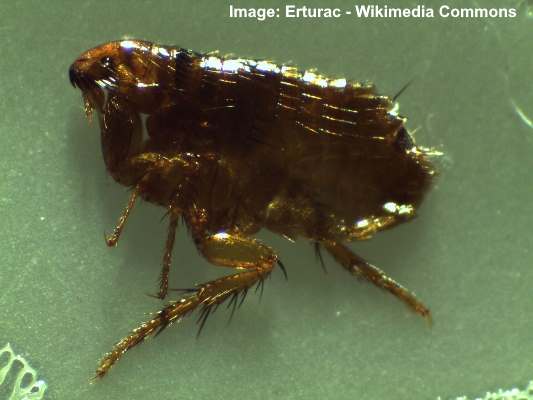
A close up picture of a flea (35x zoom optical microscope)
Fleas are small brownish-black bugs commonly found in homes with pets. The tiny insects are known for their flattened bodies and long back legs, allowing them to jump long distances. Although they are dark brown, they appear black to the naked eye. Adult fleas measure 0.12” (3 mm) long.
Fleas commonly get into houses on household pets, like dogs and cats. However, they can also infect humans. Flea bites can cause itching and discomfort and, in some cases, can transmit diseases. Fleas are known for their ability to reproduce quickly, making them difficult to control once an infestation occurs.
How to get rid of small black bugs
Getting rid of fleas and small black bugs the size of a sesame seed requires a multi-tasked approach. First, keeping pet bedding, carpeted areas, and baseboards clean is vital. Then, it’s necessary to bathe pets with soap and warm water and use a flea comb to remove the tiny critters. Regular pet flea treatment can also help prevent bug infestations in your house.
Black Ants (Lasius niger)
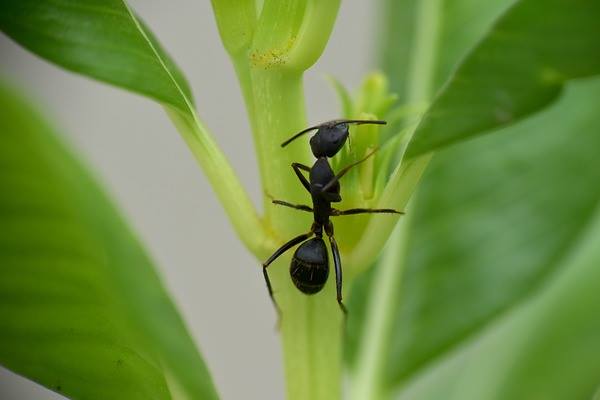
The common black ants can get into the house and are attracted especially to sweet soft fruit
The common black ant usually finds its way into homes through cracks and crevices around doors and windows. The small black intruders are identified by their glossy black segmented body, six legs, and long antennae. Black ants measure 0.12” to 0.20” (3 – 5 mm) long.
Black ants are social insects that live in large colonies. Worker ants forage for food and search out water. Therefore, they commonly become a nuisance when they infest indoor spaces. Also, they leave pheromone trails which attract other ants, making the ant infestation even worse.
How to get rid of small black bugs
The best way to get rid of small black ants is to prevent them from entering your home. Therefore, always remove their food source—food debris from countertops, keep food items in airtight containers, and fix any leaking pipes under the sink to reduce excess moisture buildup.
In some cases, using traps or ant repellants can help reduce their numbers indoors.
Bed Bugs (Cimex)

Enlarged picture of a bed bug – The tiny brown bed bugs look black but are actually brown
Bed bugs are small insects that look black to the naked eye but are reddish-brown. The tiny dark bugs have a flattened, oval body, six legs, and two antennae. However, the dark brown bugs are so tiny you can only see their identifying features under a microscope. They grow 0.16” to 0.20” (4 – 5 mm) long.
Bed bugs are difficult to spot because of their tiny size. They may look like tiny black pin-pricks clustered in the corners of bed frames, behind headboards, or in mattresses.
Signs of a bed bug infestation include small dark spots on bedding and mattresses and reddish-brown stains on bedding, pillows, and sheets. Other signs include an unpleasant musty odor from the bugs’ scent glands in the room or house. You may also find shed skins or poppy seed-like frass around your mattress, furniture, and other areas of the house.
How to get rid of small black bugs
Getting rid of bed bugs can be a daunting task. First, look for evidence of the nasty pests—small dark reddish-brown creatures about the size of an apple seed.
Next, vacuum all possible hiding places and put linen in a sealed plastic bag. It’s necessary to wash all fabrics in hot water and then in the dryer for 30 minutes on the hottest setting. It may be necessary to steam-clean mattresses. In some cases, professional help is necessary to get rid of bed bugs for good.
Fungus Gnats (Sciaridae)
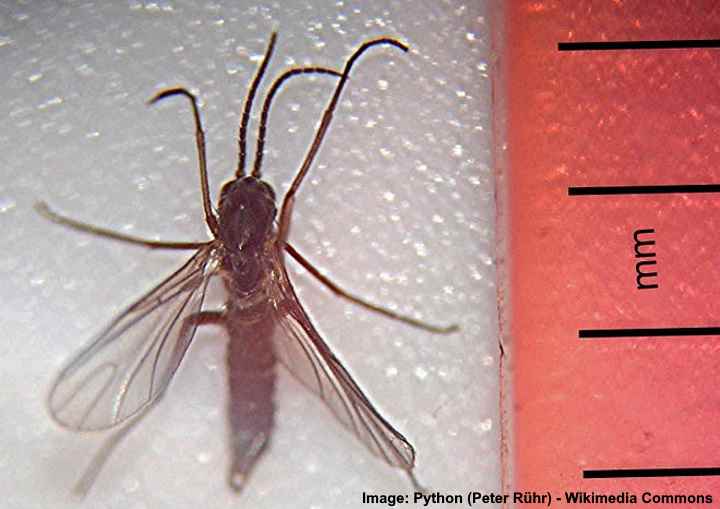
Gants are small black flying bugs that can be found in damp places in the house
Fungus gnats are small, black bugs with wings commonly seen hovering around potted house plants. The tiny black flies measure 0.12” (3 mm) long. These small flying household pests are attracted to damp environments, such as overwatered houseplants and decaying organic matter. The slender flying pests don’t harm plants but are nuisance bugs when flying around faces, noses, and eyes.
Signs of black fungus gnats in your home are small flies near houseplants. Because of their small size and erratic flying behavior, they are easy to mistake for fruit flies or drain flies.
If you notice fungus gnats, you should water your plants less frequently to allow the top layer of soil to dry out. This is because the black bugs thrive in moist soil.
How to get rid of small black bugs
To get rid of black bugs in your plant soil, create a soil drench with 3% hydrogen peroxide. You should mix one part hydrogen peroxide with four parts water. Pour it into the soil until it drips out the bottom. This will flush the soil and kill fungus gnat larvae, breaking their life cycle.
Related reading: How to get rid of fungus gnats from houseplants.
Drain Flies (Psychodidae)
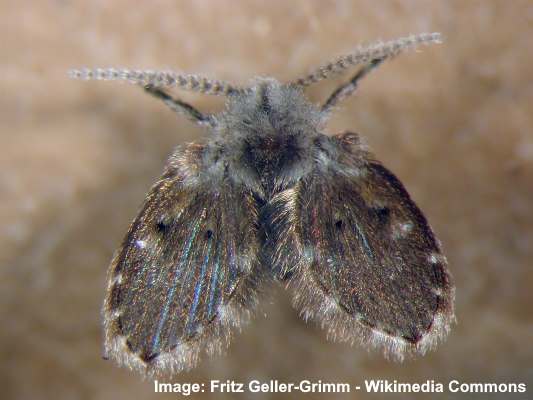
Drain flies are tiny flying house bugs with dark furry look
Drain flies are small grayish-black flying bugs with a fuzzy appearance that fly near sinks and drains. The tiny black flies measure 0.12” (3 mm) long. Their most distinguishing feature is their densely hairy wings, giving them a moth-like appearance. The fuzzy flies are typically noticeable in kitchens or bathrooms where they live in slimy filth in drains.
They may look like fruit flies, but they are not. Drain flies typically don’t fly around rotting fruit. Instead, the tiny bugs lay eggs in the slime found in sewers and drains. While they do not carry disease, they can be persistent nuisances because of their numbers and the difficulty of eliminating them.
Due to their habitat, other names for drain flies include filter flies, sink flies, sewer flies, sewer gnats, and moth flies.
How to get rid of small black bugs
To get rid of small drain flies, you must first identify the source of the infestation. To do this, inspect all drains for signs of organic matter, sludge, or slime in the pipes. Next, pour boiling water to kill the flies, larvae, and eggs. Using a pipe brush or drain snake may also be necessary to remove thick sludge.
You can also make a DIY drain cleaning solution by mixing half a cup of salt, half a cup of baking soda, and a cup of vinegar. Pour down the drain and leave overnight. In the morning, pour boiling water into the drain to get rid of drain flies for good.
Phorid Flies (Phoridae)
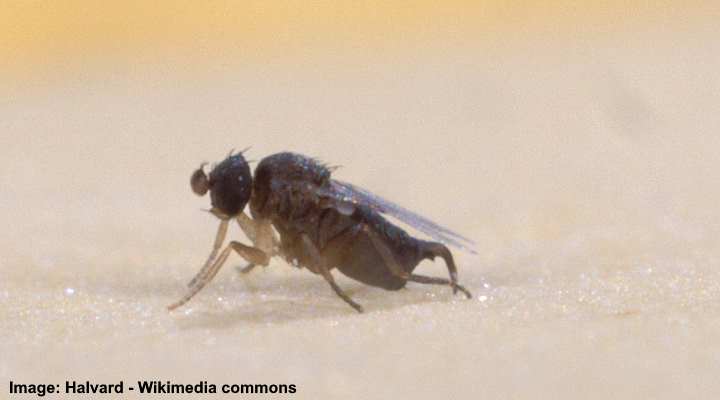
The tiny black phorid flies are identified by their humpback and erratic flight and can be found in unsanitary places
Phorid flies are small black flying bugs that resemble fruit flies or gnats. These tiny black flies have a humpbacked appearance, dark gray, black, or brown bodies, and translucent wings. A distinguishing feature is their erratic flying behavior close to surfaces. The tiny flies measure 0.02” to 0.23” (0.5 – 6 mm) long.
Phorid flies commonly feed on decaying organic matter, such as rotting food, garbage, or dead animals. They can also infest homes and buildings, becoming a nuisance pest. Therefore, they can spread disease by infesting raw food with contaminated organisms.
How to get rid of small black bugs
Because they are so tiny, phorid flies are notoriously difficult to eliminate from houses. They can nest in dirty mop heads, damp areas under kitchen cabinets, and rotting organic matter. Once you find where they have been nesting, clean the area thoroughly to remove eggs, larvae, and flies. This will also help prevent future infestations.
If the pesky flies are still a problem, you can try using sticky fly traps to reduce their number indoors.
Black Widow Spiders (Latrodectus)
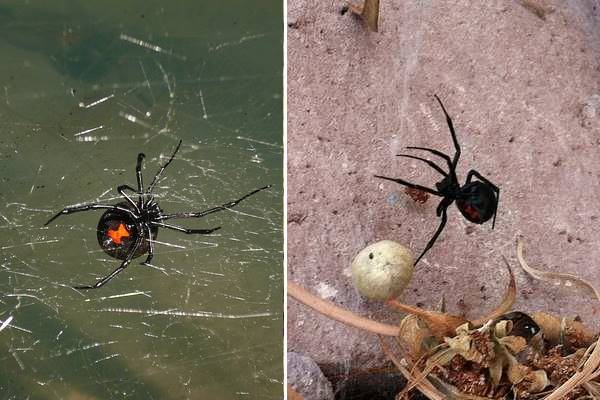
The female black widow spider (Latrodectus mactans) has a black body with a distinctive red hourglass marking on its underside belly
Black widow spiders are some of the most dangerous black bugs in houses. The biting spiders are identified by their distinctive shiny black body, reddish hourglass marking, and long black legs. The black spiders measure 0.12” to 0.39” (3 – 12 mm) long. However, their long legs make the menacing venomous spiders look larger.
Black widows generally live in dark, secluded places in houses, garages, barns, and basements. They prefer undisturbed places; you may find them under furniture, shoes, and coat pockets. The black spiders are common in houses in the eastern United States and west to Texas, Kansas, and Oklahoma.
The most common signs of a black widow problem are messy webs in dark corners.
How to get rid of small black bugs
You can get rid of black widow spiders and other pesky arachnids by using a vacuum cleaner to suck them up. Additionally, you can create a spider killer spray by mixing equal parts of vinegar and water. The acidic content of vinegar will kill the spiders on contact.
Ticks (Ixodida)
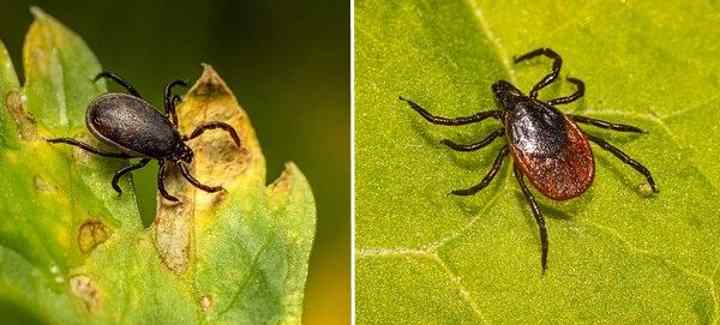
Adult black-legged male tick (left) is smaller and black, whereas the female (right) is black and brown
Ticks are small black bugs about the size of an apple seed. To the naked eye, ticks have a black body and legs, but females look dark brown with a pear-shaped body up close. The tiny black or brown bugs measure 0.01” (2.5 mm). They are known for their habit of feeding on animal and human blood when they bury in the skin for a blood meal.
Ticks primarily live outdoors in tall grasses, woodlands, and parks. They get into homes after hitching a ride on your clothing or pets. Usually, you will notice a tick as a tiny black mole-like object stuck to your or your pet’s skin.
If you have been hiking or walking in parks or woodlands, checking yourself for ticks when returning home is always a good idea.
How to get rid of small black bugs
Properly removing ticks is crucial to prevent leaving parts of the bug behind and minimize infection risk. Medical professionals suggest using tweezers to grip the tick as close to the skin’s surface as possible. Lift the tick upwards delicately to extract it from you or your pet’s skin.
Small Black Bugs With Hard Shell
Black Carpet Beetles (Attagenus unicolor)
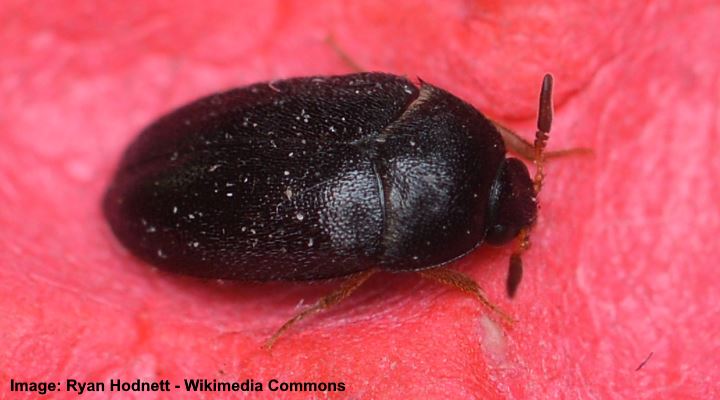
The black carpet beetle is a tiny bug that infests carpets and fabrics in the house
The black carpet beetle is a small, oval-shaped bug with a shiny black body and hard shell. The tiny black beetles are slightly rounded, and adult carpet beetles measure 0.13” to 0.20” (3 – 5 mm) long. Their larvae are hairy and brown and feed on fabrics.
Black carpet beetles are common household pests that can infest carpets, furniture, and clothing. Their larvae feed on natural fibers such as wool, silk, and fur, causing damage similar to clothes moths, resulting in large, irregular holes. These beetles are highly destructive, causing damage to clothing fabrics, carpets, and other soft materials in your home.
To identify black carpet beetles, look for their small size, shiny black color, and bristly larvae. You can usually find the black bugs on window sills because light attracts them. However, their eggs and carpet beetle larvae are generally found in carpets.
How to get rid of small black bugs
Regularly cleaning carpets and countertops and storing food in airtight containers are the best prevention methods. Like eliminating most indoor pests, vacuuming is a highly effective way of getting rid of beetles and black bugs.
Black Pantry Bugs
Pantry bugs, also known as kitchen pests, are a group of black bugs or dark brown beetles and weevils that infest stored dry foodstuffs. The tiny black bugs are found in pantries, kitchen cabinets, and other food storage areas. They can contaminate and spoil food products.
Signs of pantry bugs are silk webbing in packaging, black dots that look like poppy seeds (feces) and cast skins.
Here are common types of black or dark bugs that are considered pantry pests:
Spider beetles (Ptinidae): Tiny reddish-brown to black beetles that are 0.06 to 0.14” (1.5 – 3.5 mm) long. You may find them in dry food items like cereals, flour, spices, and grains.
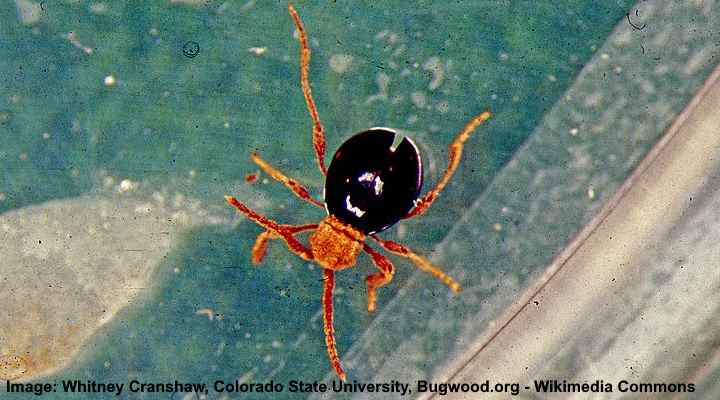
American Spider Beetle (Mezium americanum)
Rice weevils (Sitophilus oryzae): They appear dark brown or black but are reddish brown with orange spots. The pantry bugs measure 0.12” to 0.18” (3 – 4.5 mm) long.
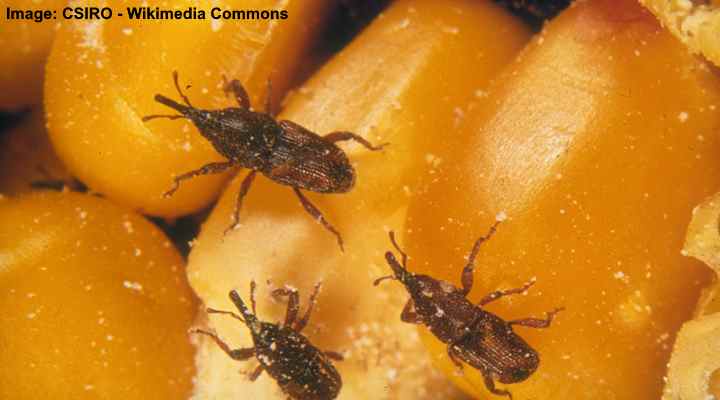
Rice weevils (Sitophilus oryzae)
Granary weevils (Sitophilus granarius): These small beetles are dark brown to black and have a distinctive elongated snout, typical of weevils. You’ll find them in oats, rice, wheat, corn, and barley.
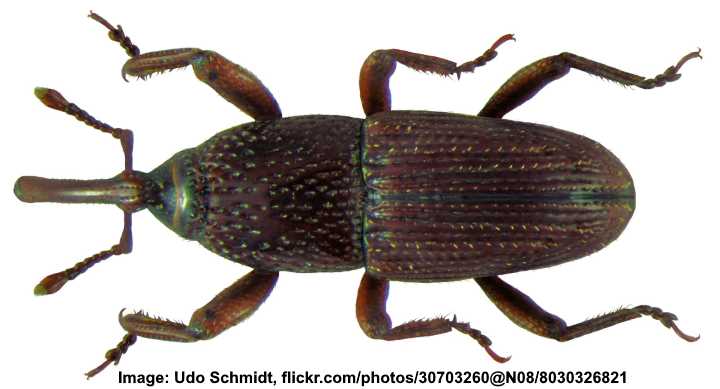
Granary weevil (Sitophilus granarius)
Black flour beetles (Tribolium confusum and Tribolium castaneum): These small beetles are dark brown to black and have a compact and oval-shaped body. They measure 0.12” (3 mm) in length. Infested food products may have a rancid odor and a black pepper-like substance (frass or feces).
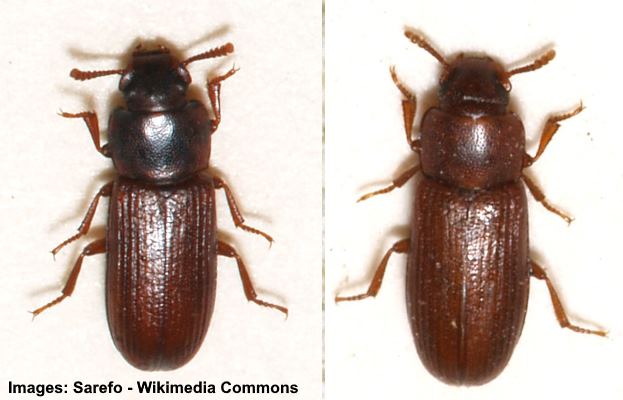
Flour beetles (Tribolium confusum on the left and Tribolium castaneum on the right)
How to get rid of small black bugs
To prevent pantry bug infestations, maintaining good food storage practices is crucial. Use airtight containers to store dry food items and regularly inspect stored products for signs of infestation.
If you spot signs of pantry bugs, it’s vital to clean all shelves thoroughly, dispose of infested food products, and repackage stored dry food products in airtight containers.
Related articles:
